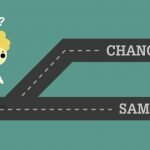One of my favorite best practices in UX is the use of “mental models”. Mental models help UX designers and content strategists create experiences that make sense.
For example, a mental model of a door has it open from the side. This is a mental model so ingrained that no one would think to design a door that opened from the top. Now think about how someone navigates from one “page” on a website to a linear “next” page. Following the door mental model, most people look to the side of the screen for an arrow or “next” signal. They don’t look at the center of the page if they’re expecting a linear progression.
But lately I’ve been thinking about how closely our mental models are connected to our personal experiences. So now I want to revisit and re-connect them to user needs.
What are Mental Models?
According to the Mental Models Global Laboratory, a mental model is “how the mind represents real, remembered, hypothetical, or imaginary situations.” With mental models, there’s no need to invent new design patterns (within reason). Instead, the first step is to identify or build on what already exists. Even if the team is building something “brand new” there’s a model in a related experience.
This is often linked to the design heuristics “match between system and the real world” and “recognition rather than recall”. In other words, if people are used to seeing a shopping cart icon to mean “view cart” then now is not the day to put an eyeglass icon there instead.
A mental model is a great way to move away from “what I like” into “what a person would do.” But how do you know you haven’t just moved into “what I would do”?
Unbiased Research
Since mental models are based on expectations, they require research. Specifically, they require unbiased research with the target audience. Here are a few tips to find the right ones for your project.
- Listen to the target audience
Not every mental model is appropriate for every audience. I have a mental model of how a search engine works, which my father (who doesn’t use search engines) does not share. Cultural background, industry, and education can all play a role in someone’s mental model. - Don’t rely on personal experience
A colleague recently suggested that we set up an in-app feedback request to mirror the way app stores ask for reviews. Her belief was that “everyone” leaves reviews. My belief was that “no one” does. A quick Google search helped us find statistics! - Disconnect the UI choice from the motivation
Mental models are best for helping people recognize their options. They are not inherently motivational tools, though making things easy to do can help tap into a person’s motivation. Still, focus the mental model on meeting expectations and ease-of-use, not in assuming others will act in the way you might.
Mental Models as a Tool
A mental model can be formalized through domain mapping, and even formed in part through the experience you build. There’s so much that UX practitioners need to invent – mental models ensure we invent new things, and don’t reinvent the wheel.
With careful research and self-awareness, we can make sure our mental models lead to unbiased experiences.


